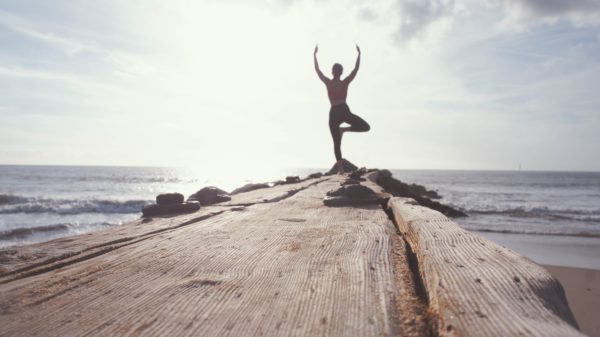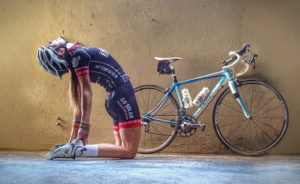After putting miles in on your bike, it’s important to give your body some relief. Not only does this mean adequate rest days to give yourself time to recover, but a specific yoga sequence for cyclists can help those muscles out a little. Luckily, yoga has your back (and hamstrings and hips).
The key to yoga is to give yourself the adequate amount of time to relax into each pose. Whether you’re a yogi or not, taking time to reach those deep stretch targets and work on your breathing can help you become a more efficient cyclist. Anything less than 30 seconds won’t make a significant difference in lengthening the muscle fibers and tissue, but holding too long too soon can put you at risk of injury.

The Benefits of Yoga for Cyclists
Core Strength
A strong core is vital for cycling power, posture, and injury prevention, especially in your lower back region. As a result of the bent over position on your bike, many cyclists have highly developed back muscles, with comparatively weaker abdominal muscles.
This muscular imbalance is normal, but can cause issues in the long run. If you’re tired at the end of a long ride and have poor core strength, you will be more likely to slump in the saddle. This will place undue pressure on your shoulders and wrists, as well as cause lower back pain once off your bike.
Flexibility & Posture

Much in line with your core strength, maintaining proper posture on your bike will prevent injury. The natural inclination is to round your back as you crane your head to look forward. Not only does this create drag, but it will eventually cause pain in your lower and upper back and neck.
Everything in your body is connected. So, to maintain proper bike posture you have to have adequate flexibility in your lower back, hips, glutes, and hamstrings. The flatter your back can be, the less issues you’ll come up against in your training. Yoga can help you not only build the strength and flexibility to hold your posture, but also help you become constantly aware of how your body is feeling.
Breathing
You may not put much thought into your breathing when you’re attacking a hill. The pressing thought for most is to simply keep breathing, even if it looks more like panting. However, when transformed from an automatic function, it can be great training tool.
Yoga can help you learn how to monitor your breathing, making the most of each breath. It can train your body to take slower and deeper breaths to maximize your oxygen intake.
 Injury Prevention
Injury Prevention
Yoga is ideally injury prevention rather than treatment, but it can help on both ends of the spectrum. Regular stretchingand yoga will reduce your risk of suffering from the typical overuse injuries that plague cyclists. These include IT band syndrome, tight hamstrings, back pain, and knee problems.
Because your legs never fully extend on the bike, your muscles get little chance to fully lengthy. There is also an imbalance of strength, with so much power coming from certain muscles, while others remain underdeveloped. Ensuring you are working and stretching these muscles off the bike will go a long way to keep things balanced.
What a Yoga Sequence for Cyclists Should Look Like
Although we’d all rather be out on our bikes than cross training, given everything listed above taking 20 minutes our of your day to practice yoga can keep you feeling your best while you are out on the road. If you’re not ready to go to an hour long yoga class, whether it be the time or financial commitment, you can piece together your own routines to do at home. Here’s what you should know before getting started.
Same time, same place.
Starting around the same time every time is the best way to turn good intention into a habit. Starting you day off with yoga can be one of the best ways to wake up y our body and mind and get you ready for the day.
From the ground up.
A great rule is to start on your mat, with poses that have your body on the ground, and work your way up. This gives your body time to work up to the more active standing poses.
Be focused.
Remove all distractions if you can. Leave your cellphone in a different room and set aside the time to just stretch. Be patient with yourself in the beginning, as it may take time to quiet your mind.
Keep it simple.
Practicing at home is a wonderful thing, but you’ll want to keep it simple. Start out by following along with the video routine below, or just begin with just these 4 poses. If you want more routines like this one, check out Dynamic Cyclist for more stretching routines for cyclists.